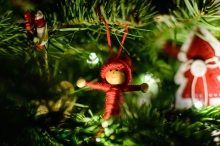-
DIE ZEIT | Nachrichten, News, Hintergründe und Debatten
Südkorea: Staatsanwaltschaft fordert zehn Jahre Haft für Ex-Präsident Yoon
26/12/25 08:32:29
Nach der Ausrufung des Kriegsrechts in Südkorea fordert die Anklage eine lange Haftstrafe für Ex-Präsident Yoon Suk Yeol. Ihm werden Wahlbetrug und Aufruhr vorgeworfen.
Krieg gegen die Ukraine: Wolodymyr Selenskyj kündigt baldiges Treffen mit Donald Trump an
26/12/25 08:27:38
Noch im alten Jahr könne "vieles entschieden werden", sagt der ukrainische Präsident. Zuvor hatte er die Gespräche mit Donald Trumps Gesandten gelobt. Das Liveblog
Lange Rote: Es geht um die eine Wurst
26/12/25 08:11:29
Am Freiburger Münster bieten fünf Stände Würste zu nahezu identischen Preisen an. Man lernt hier einiges darüber, wie Wettbewerb funktioniert. Und wann er eskaliert.
-
DER SPIEGEL - Schlagzeilen – Tops
Daron Acemoğlu: Warum der Nobelpreisträger ein turbulentes Jahr 2026 erwartet
23/12/25 13:00:00
Nobelpreisträger Daron Acemoğlu erwartet ein turbulentes Jahr 2026. Die USA und China gingen bei KI in die falsche Richtung – und Trump höhle die Institutionen aus. Ohne Kurskorrektur werde die Wirtschaft in den nächsten Jahren abschmieren.
USA greifen IS-Stellungen in Nigeria an
26/12/25 06:34:00
Donald Trump spricht von »perfekten Angriffen«: Der US-Präsident meldet tödliche Luftschläge gegen IS-Terroristen im Nordwesten Nigerias. Die Regierung des afrikanischen Landes bestätigt die Attacken.
Globale Ordnung: Deutschland bereitet sich auf eine Welt vor, die es nicht gibt
25/12/25 10:26:00
Berlin wappnet sich für eine neue Konfrontation der Großmächte. Tatsächlich jedoch braut sich etwas zusammen, das noch viel gefährlicher ist.
Visaverfahren: Teure britische Visa und erschwerte Einreise für Deutsche in Malaysia
26/12/25 06:55:00
Wer im Ausland unterwegs ist, muss meist erst mal durch eine sonderbare Bürokratie. In Großbritannien etwa kostet ein Visum schnell Tausende Euro. Und in Malaysia lebt die DDR weiter, zumindest in der Datenbank.
Etsy: Wie junge Frauen auf TikTok von Online-Hexen schwärmen
25/12/25 21:48:00
Rauhnächte waren gestern. »Etsy-Hexen« sind der neue spirituelle Trend. Was Wahrsagerinnen und Schamanen auf der Online-Verkaufsplattform versprechen – und wann Anbieter zur Gefahr werden.
-
DER SPIEGEL - Videos
Der große SPIEGEL-TV-Jahresrückblick 2025: Menschen und ihre Geschichten
25/12/25 21:05:00
Eigentlich waren es zwölf Monate im politischen Krisenmodus: Neuwahlen, Migrationsstreit, »Stadtbild«-Debatten, Mietenwahnsinn, Gaza und Ukraine. Doch manchmal war das Jahr für unsere Reporter auch unterhaltsam und skurril.
Weihnachten: Frank-Walter Steinmeier spricht in Ansprache über Mut und Hoffnung
25/12/25 19:00:00
Für Frank-Walter Steinmeier ist Weihnachten mehr als ein Fest der Bräuche und Rituale. In seiner Ansprache geht es dem Bundespräsidenten vor allem um Mut und Hoffnung. Und um Solidarität mit der Ukraine.
Knigge: Wie isst man einen Döner richtig?
25/12/25 13:29:00
Wo beiße ich zuerst ab? Sollte ich die Zwiebeln weglassen? Und wie zum Teufel kleckere ich mich nicht voll? Ein Knigge-Experte zeigt unserem SPIEGEL-Reporter: So ist ein Döner zu verzehren, mit Anstand.
Bergretter in den Alpen: Herausforderungen der Rettungseinsätze im Skigebiet
25/12/25 10:28:00
Wenn sie gerufen werden, muss es schnell gehen: Während der Skisaison fliegen Rettungskräfte Hunderte Einsätze in den französischen Alpen. Einblicke in eine Arbeit, die in Zukunft noch intensiver werden dürfte.
Donald Trump will Design neuer Kriegsschiffe mitgestalten
23/12/25 12:24:00
Donald Trump will eine »Goldene Flotte« für die Navy bauen lassen und die Kriegsschiffsklasse nach sich selbst benennen. Auch beim Design möchte er mitmischen. Als Vorgeschmack präsentierte er martialische Gemälde im Comicstil.
-
Wissenschaft-aktuell
Der Gipfel des Gletscherschwunds
17/12/25 00:00:00
In den Alpen könnten dieses Jahrhundert nahezu alle bis auf gerade mal 20 Gletscher verschwinden – Höhepunkt des Schwunds bis 2040 erwartet
Zugreifen mit Schallwellen
10/12/25 00:00:00
Neuer Chip kann über filigrane Struktur Schallwellen gezielt manipulieren und zu einem vielseitigen, akustischem Werkzeug verwandeln.
Warum die Erde unter Santorin bebt
05/12/25 00:00:00
Detaillierte Bebenanalyse offenbart eine komplexe Dynamik flüssigen Magmas unter dem hellenischen Inselbogen
-
Spektrum.de RSS-Feed
Dekabristen: Der vergeigte Putsch
26/12/25 08:00:00
Im Jahr 1825 geschah in St. Petersburg Gewaltiges: Aufständische wollten das Zarenreich komplett umkrempeln. Seither entfachte ihre Idee immer wieder das Feuer der Unabhängigkeit.
Inspiration: Das Wunder der Eingebung
25/12/25 15:00:00
Wie entstehen plötzliche Geistesblitze? Was während eines Aha-Moments im Gehirn passiert – und welche Bedingungen kreative Durchbrüche begünstigen.
Outtakes 2025 • Urknall Weltall und das Leben | UWudL-Team
25/12/25 14:15:33
Harald Lesch, Josef M. Gaßner, Andreas Müller, Axel Schwope, Peter Kroll, Stefan Heusler, Axel Kleidon & das UWudL-Team präsentieren die Outtakes des Jahres 2025. Das gesamte UWud
Das Jahr 536 und die Spätantike Kleine Eiszeit
25/12/25 14:14:32
Wir springen in dieser Wochen ins Jahr 536, das nicht nur ein schicksalsträchtiges Jahr ist, sondern mit der Spätantiken Kleinen Eiszeit im Grund das Ende der Römischen Welt einleitet. / 🎙️
Limes-Effekt: Die süddeutsche Mentalität – ein Erbe der Römer?
25/12/25 12:00:00
Dort, wo vor Jahrhunderten die Römer herrschten, sind die Deutschen heute ein wenig ausgeglichener und zufriedener. Sind das die Spätfolgen des antiken Reichs? Eine Spurensuche.
-
Latest Science News -- ScienceDaily
A Christmas tree 80 light-years wide appears in space
25/12/25 15:04:41
This Christmas, astronomers are highlighting a spectacular region of space that looks remarkably like a glowing holiday tree. Known as NGC 2264, this distant star-forming region sits about 2,700 light-years away and is filled with newborn stars lighting up clouds of gas and dust. The stars form a triangular shape called the Christmas Tree cluster, crowned by the dramatic Cone Nebula and wrapped in the swirling Fox Fur Nebula below. Together, these features create a festive cosmic scene spanning nearly 80 light-years, showing how young stars shape their surroundings on a truly galactic scale.
Astronomers discover one of the Universe’s largest spinning structures
25/12/25 15:50:50
Scientists have discovered a giant cosmic filament where galaxies spin in sync with the structure that holds them together. The razor-thin chain of galaxies sits inside a much larger filament that appears to be slowly rotating as a whole. This coordinated motion is far stronger than expected by chance and hints that galaxy spin may be inherited from the cosmic web itself. The finding opens a new window into how galaxies formed and how matter flows across the Universe.
How Earth endured a planet-wide inferno: The secret water vault under our feet
26/12/25 07:09:12
When Earth was a molten inferno, water may have been locked safely underground rather than lost to space. Researchers discovered that bridgmanite deep in the mantle can store far more water at high temperatures than previously believed. During Earth’s cooling, this hidden reservoir could have held water volumes comparable to today’s oceans. Over time, that buried water helped drive geology and rebuild the planet’s surface environment.
Oceans are supercharging hurricanes past Category 5
25/12/25 17:03:27
Deep ocean hot spots packed with heat are making the strongest hurricanes and typhoons more likely—and more dangerous. These regions, especially near the Philippines and the Caribbean, are expanding as climate change warms ocean waters far below the surface. As a result, storms powerful enough to exceed Category 5 are appearing more often, with over half occurring in just the past decade. Researchers say recognizing a new “Category 6” could improve public awareness and disaster planning.
This popular painkiller may do more harm than good
25/12/25 17:52:44
Tramadol, a popular opioid often seen as a “safer” painkiller, may not live up to its reputation. A large analysis of clinical trials found that while it does reduce chronic pain, the relief is modest—so small that many patients likely wouldn’t notice much real-world benefit. At the same time, tramadol was linked to a significantly higher risk of serious side effects, especially heart-related problems like chest pain and heart failure, along with common issues such as nausea, dizziness, and sleepiness.
-
In-Mind
Ist Weihnachten wirklich ein Fest für alle?
20/12/25 13:13:49
 Weihnachten ist für viele eine Zeit der Freude und Gemeinschaft. Doch wie erleben Menschen diese Zeit, die Weihnachten nicht feiern? Im letzten Teil der Weihnachtsserie werfen wir einen Blick auf die psychologischen Auswirkungen von Weihnachtsdekoration auf Nicht-Christ:innen und untersuchen, ob die Feiertage Vorurteile gegenüber Andersgläubigen verstärken können.
Weihnachten ist für viele eine Zeit der Freude und Gemeinschaft. Doch wie erleben Menschen diese Zeit, die Weihnachten nicht feiern? Im letzten Teil der Weihnachtsserie werfen wir einen Blick auf die psychologischen Auswirkungen von Weihnachtsdekoration auf Nicht-Christ:innen und untersuchen, ob die Feiertage Vorurteile gegenüber Andersgläubigen verstärken können.
Wie kann ich die Weihnachtszeit so gestalten, dass sie mir guttut?
13/12/25 17:38:10
 Die Vorweihnachtszeit kann eine Zeit der Extreme sein: Vorfreude und Heimeligkeit treffen auf stressigen Geschenkekauf und unvollendete Jahresvorsätze. Doch wie kannst du diese Zeit nicht nur überstehen, sondern auch genießen? In Teil 3 der Weihnachtsserie erfährst du, welche Bedingungen dein vorweihnachtliches Wohlbefinden steigern und welche es eher beeinträchtigen können.
Die Vorweihnachtszeit kann eine Zeit der Extreme sein: Vorfreude und Heimeligkeit treffen auf stressigen Geschenkekauf und unvollendete Jahresvorsätze. Doch wie kannst du diese Zeit nicht nur überstehen, sondern auch genießen? In Teil 3 der Weihnachtsserie erfährst du, welche Bedingungen dein vorweihnachtliches Wohlbefinden steigern und welche es eher beeinträchtigen können.
All I want for Christmas is… Geschenke! Warum wir schenken und wie das ankommt
05/12/25 14:28:16
 Mit dem nahenden Weihnachtsfest beginnt für viele die Geschenkesuche. In Teil 2 der Weihnachtsserie werfen wir einen Blick auf verschiedene psychologische Hintergründe des Schenkens.
Mit dem nahenden Weihnachtsfest beginnt für viele die Geschenkesuche. In Teil 2 der Weihnachtsserie werfen wir einen Blick auf verschiedene psychologische Hintergründe des Schenkens.
Warum Weihnachten (gefühlt) jedes Jahr schneller kommt
28/11/25 10:25:13
 Weihnachten steht vor der Tür – und damit der alljährliche Eindruck, dass die Zeit immer schneller vergeht. Hast Du auch dieses Gefühl ? In Teil 1 der Weihnachtsserie des In-Mind Blogs erfährst du, warum das so sein könnte
Weihnachten steht vor der Tür – und damit der alljährliche Eindruck, dass die Zeit immer schneller vergeht. Hast Du auch dieses Gefühl ? In Teil 1 der Weihnachtsserie des In-Mind Blogs erfährst du, warum das so sein könnte
Schicksal oder Wachstum? Über Glaubenssätze und Zufriedenheit in Paarbeziehungen
17/11/25 16:27:32
 Bestimmt das Schicksal ob eine Beziehung gelingt oder liegt es in unserer eigenen Hand? Eine aktuelle Studie zeigt, dass unsere Sicht auf Paarbeziehungen beeinflussen kann, wie glücklich wir langfristig miteinander sind.
Bestimmt das Schicksal ob eine Beziehung gelingt oder liegt es in unserer eigenen Hand? Eine aktuelle Studie zeigt, dass unsere Sicht auf Paarbeziehungen beeinflussen kann, wie glücklich wir langfristig miteinander sind.
-
STERN.DE RSS-Feed Genuss - die neusten Meldungen zum Thema Genuss
Glühwein-Alternative: Lillet Hot Berry: So können Sie den französischen Aperitif heiß genießen
26/12/25 08:07:00
Nicht erst seit dem Hit "Wildberry Lillet" ist der französische Aperitif in aller Munde. Aber wussten Sie, dass Lillet auch heiß schmeckt?
Tipps: Kochen für Anfänger: Diese Grundausstattung brauchen Sie in der Küche
26/12/25 08:07:00
Sie möchten Ihre kulinarischen Kenntnisse erweitern, wissen aber nicht, wo Sie anfangen sollen? Am besten mit einer guten Grundausstattung. Was Sie noch brauchen, lesen Sie hier.
Rezept: Mit diesen Weihnachtscocktails liegen Sie 2025 voll im Trend
24/12/25 12:25:00
Diese Rezepte vereinen typische Winteraromen mit moderner Optik. Barkeeper Pascal Rehm zeigt, wie Sie den Frosted Cranberry Mule, Bad Santa und den Christmas Lemon Drop zubereiten.
Wie bei Oma : Locker, knusprig, lecker: Rezept für saftige vegane Nussecken
24/12/25 10:59:00
Herrlich locker, knusprig und süß zugleich: Nussecken zählen zu den beliebten Klassikern. Auch vegan sind die Teilchen ein Genuss – und stehen dem Original in nichts nach. Das Rezept.
Grundausstattung: Diese Fondue-Sets enthalten alles, was Sie zum Schlemmen brauchen
24/12/25 09:31:00
Fondue wird mit geschmolzenem Käse serviert, alternativ lassen sich die auserwählten Leckerbissen aber auch in Brühe oder heißem Fett zubereiten. Wichtig ist die Grundausstattung.